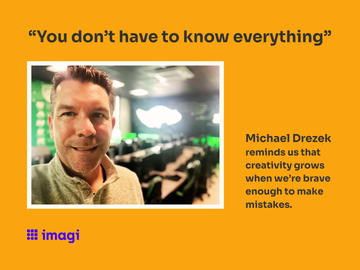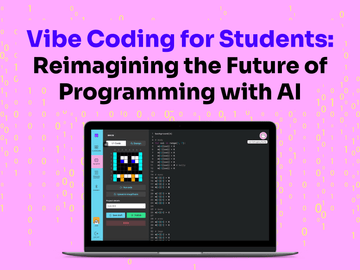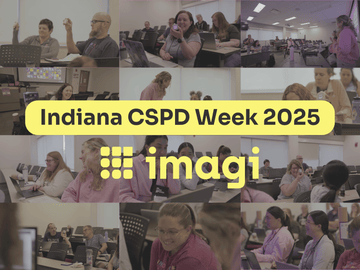
Introducing Chris Combs and His Experience with imagi
In today’s rapidly evolving world, educators must equip students with the skills they need to succeed, and technology plays a crucial role in that process. Chris Combs, a Computer Science (CS) Teacher at Helfrich Park STEM Academy, shares his experience using imagi’s innovative curriculum to inspire creativity, collaboration, and problem-solving in his students.
Willingness to Fail and the Importance of Technology Education
Technology is changing so quickly that we need to teach the kids [to be] thinkers and problem solvers.
In order for students and their teachers to succeed, they have to be willing to fail. That’s the message that Chris Combs, a CS teacher at Helfrich Park STEM Academy in Evansville, Indiana, wants educators to take from his experience with imagi and pass along to their students. As Combs stressed, our students are our future: a future that will be heavily shaped by technology. To meet those demands, Combs found imagi.
Creativity and Student Expression through imagi
“Color expresses emotion,” Combs said as he introduced a project his students completed: a self-portrait. “Color expresses detail.”
One of the features students loved the most about imagi was the opportunity to express their creativity. For example, they can bring their coding projects to life by adding vibrant colors and unique designs. Students first drew themselves, and then they took their images and coded them. In each of his projects, Combs always asked two questions when students had completed the task; whether their project represented their best work and whether they could take it one step further.

Instructional Equity and Collaboration in the Classroom
“Be willing to explore,” he said. “Be willing to fail. Be humble and ask for help. Don’t stress.”
Combs is a proponent of instructional equity in his classroom. His students represent a wide range of academic abilities and social-emotional needs, as is common in many classrooms. However, his class provides the ideal environment for students to collaborate, regardless of their academic strengths or challenges.
Combs had the students choose their partners, but there was a caveat: they could only work with those partners for a week to two weeks (depending on class size), and then they switched. They may never work with the same partner again.
He mentioned that students of all levels of academic mastery and levels of motivation can learn from one another. Students who were used to struggling and often unsuccessful in academic settings, were willing to try and fail; and oftentimes, they were the students who excelled faster than your standard high-achieving students. Those students live what Combs encourages other teachers to do.
Combs added that collaboration, an integral feature of imagi’s curriculum activities, is a skill students will need in the workforce, so this pairing system prepares them for this piece of being successful adults.
Personalized Learning and Student Engagement
Often when visitors come to observe a classroom, they may confuse compliant students with engaged students. Combs recognizes this, and through imagi and his own instructional strengths, he has created an environment truly personalized to all of his students. Through the skillful use of the imagi curriculum, he was able to emphasize a pillar of imagi: student choice and voice, which he found truly engaged all learners, even students who did not choose to be placed in his CS course.
For example, students used the imagi coding curriculum to create scrolling messages. With this activity, it is commonplace for students to code a message such as “We are #1” or a cheer for their schools. Combs takes the same academic content and personalizes it to students, asking them to create a positive message that means something to them. This personalization of learning not only drives student engagement, but it also connects with building a student’s belief in themselves, a skill that will stay with them far beyond Combs’s one-quarter course. This highlights imagi’s commitment in offering a curriculum and activities that truly engage all students and support student self-belief, which will impact their lives far beyond a classroom.

Cross-Curricular Learning and Real-World Applications
Furthermore, students using imagi not only excelled in learning programming skills, particularly Python, but also benefited from numerous cross-curricular opportunities embedded within the curriculum. For instance, for a code to be successful, students had to maintain a high level of attention to detail. In order for a written message to make sense, students must know punctuation conventions, such as placement of commas.
“It’s the old ‘Let’s eat, grandma’ versus ‘Let’s eat grandma,” laughed Combs.
By giving students real-world applications of standards normally reserved for English Learning Arts (ELA), he reinforces that learning for students in a way that helps build conceptual knowledge, which is shown to support building of specific skills in student learning. Programming language syntax parallels with ELA constructs, again reinforcing that core content.
Leveraging imagi's Accessibility to Foster Critical Thinking and Student Success
Combs, a teacher with almost a decade and a half of experience, has taken imagi and skillfully customized it to meet the needs of his students, including necessary skills for students’ success, such as critical thinking and problem solving. Combs noted he provided students with clear parameters, but still remained purposefully vague, so as to offer students a choice in exactly how they meet the parameters of the assignment.
When discussing the final assignment of the course, Combs explained that he didn’t care how they coded. He noted that if students remembered “tricks,” they could possibly code in 15 lines, whereas students who weren’t as aware of the shortcuts may use 100 lines to complete the same assignment.
Additionally, the ability to revisit past lessons with imagi, provided support to students in their final project or other missed work. For the final project, Chris noted that students were able to use imagi’s resources to work at their own pace, with access to past lessons for extra support.
Advice for Implementing imagi in the Classroom
Her [Dora’s] passion for the program was energizing and kept my interest… After the meeting and throughout the next day, I couldn’t stop thinking about the possibilities and options of imagi in my class.
For teachers looking to implement imagi, Combs offers some advice. His implementation was spurred by a presentation from Dora Palfi, co-founder and CEO of imagi.
From there, Chris did what he suggested interested teachers do: do your research. He looked into plans and came up with a proposal for his central office, which included a small number of charms for his classes. His advice? Dream big. Don’t start at the bottom level. He mentioned that, in your negotiations, there is a “stair step” pattern to the levels for implementing imagi. First were the free lessons with no charms. Next, you could pitch a class set of charms. For the best opportunity for your students, though, Combs suggested a 1:1 for students if not a 2:1, the latter being important for paired projects.
Preparing Students for the Future
Our job as educators and education leaders is to support student learning, and Combs knows from first-hand experience that imagi does just that. Using imagi in his classroom has allowed Combs to help his students build academic skills and critical abilities including collaboration, problem solving as well as critical thinking. All of which are important for their future and for shaping a better future for all.
“The kids are the future of America,” Combs said. “And I want America to be the best it can be.”
This interview was conducted and edited by Dr. Rhiannon Dunn. Dunn served in roles ranging from student support to teacher to assistant principal for almost two decades. She serves as an educational consultant now whose aim is to use her platform to elevate teacher and student stories to showcase the power of education, specifically the intersection of high-yield instructional strategies and the purposeful use of educational technology. Dunn champions the idea that the power of the universe lies foremost in our classrooms.




